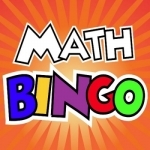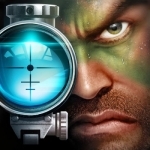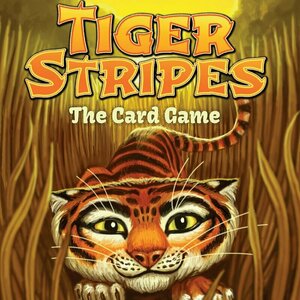
Math Bingo
Education and Games
App
The original Math BINGO! Over 1 Million Players! - Featured in The New York Times - Oct 2011...

Kill Shot Bravo
Games and Entertainment
App
Kill Shot Bravo - Play the #1 Shooter on Mobile! Become the Deadliest Special Forces Solider! Arm...
Purple Phoenix Games (2266 KP) rated Tiger Stripes in Tabletop Games
Nov 25, 2021
Tiger Stripes is a set collection, hand management, drafting game for two to four players. In it, players are young tiger cubs just earning their stripes (a fact I did not know prior to playing: that tiger cubs aren’t born with stripes). Each cub will earn their stripes by drafting the best available cards and utilizing them to the fullest in order to collect sets of prey.
Oh fact check: tigers are born with stripes already, so this game is not based fully on facts.
DISCLAIMER: We were provided a copy of this game for the purposes of this review. This is a retail copy of the game (I think), so what you see in these photos is probably what would be received in your box. I do not intend to cover every single rule included in the rulebook, but will describe the overall game flow and major rule set so that our readers may get a sense of how the game plays. For more in depth rules, you may purchase a copy online or from your FLGS. -T
To setup, each player will choose their tiger avatar cards and also receive seven Stripe tokens. The card deck is shuffled, and each player is dealt two cards for the starting hand. The remainder of the deck is placed on the table as a draw deck, but five cards are dealt to the table as an offer row. The youngest player goes first, and the stripes are ready to be earned, like Boy Scout badges… but for ferocious tiger cubs.
Turns are taken in three steps. The player must make a choice of one action for the first step of their turn: Draw a card, Take a tiger card, or Capture Prey. A player may choose to blindly draw a card from the top of the deck and add it to their hand as their action. Alternately, the player may instead choose to take a tiger card from the offer row and add it to their hand. Both of these are self-explanatory.
The third action that can be taken is to Capture Prey. A tiger may capture prey from the offer row by discarding cards from their hand with matching symbols to their target cards they wish to capture. Each card in Tiger Stripes has one or more symbols printed in the upper left hand corner. By discarding cards from hand to the discard pile, a player may use all the symbols provided by these cards to match with cards’ symbols from the offer row. For example, a player may discard two tiger cards and a snake card, noting the symbols now provided. By using the purchasing power of these symbols, the player may then draft cards from the offer row by paying their cost in symbols. It is entirely possible for a player to be able to draft cards from hand in order to purchase all available cards in the offer row to be added to their hand. An explanation of the significance of this is coming.
The second step of a turn is mandatory only if the prerequisites are met: every set of three like cards in hand are discarded in return for Stripe Tokens. So, for every set of three matching monkey, snake, deer, and boar, the player will receive one, two, three, or four Stripe Tokens to be added to their avatar card, respectively, with any tiger cards discarded to be treated as wild cards to complete a set. Therefore, a player may wish to purchase all cards from the offer row in an attempt to score multiple sets during this second step to earn as many stripes as possible.
Finally, the third step of the turn is to Replenish the Jungle (the offer row). For any cards drafted in the turn, the player will replace with cards from the draw deck to setup the next player’s turn.
Play continues in this fashion of grabbing cards, discarding cards, and scoring sets for stripes until one player has earned their seventh stripe and won the game!
Components. This game is a deck of cards and a bunch of Stripe Tokens. The cards are all nice quality, with linen finish, but are a bit on the thinner side as far as flimsiness is concerned. I think if players are all somewhat careful this will not pose problems. If so, consider sleeving your copy. The Stripe Tokens are oblong octagons with stripey art. Speaking of the art, throughout the game the art is very cute and cuddly… except for the boar. He is crotchety. I do enjoy finding the stalking tiger somewhat hidden on each card’s art. A great nod to the noble tiger’s hunting ability.
Now, as I was typing the rules breakdown I felt like I was typing quite a lot for as light as the game actually is. In fact, though it says on the box that it is intended for ages 7+ I just couldn’t leave out my little 5-year-old gamer son. He grasped the rules really well, and though he hasn’t developed the best strategy-focused brain skills yet, he is still able to play and enjoy Tiger Stripes. In actuality, he and I had a blast playing through this several times. Yes, it is a resource optimization card drafting game, but to him, it was more like procuring a veritable zoo of cute animals that then offered his tiger the stripes needed to win. And win he did. Several times. This certainly isn’t a game of high strategy and multiple-minute turns, but rather a quick and easy card game with a great little theme.
Is the designer, Isabel duBarry, a relative of the great Philip duBarry? Perhaps. And that is a great thing, because one of our favorite games across the board is Revolution! Perchance game design just runs in the family. I am not sure, so maybe someone can chime in on this here.
When my son adds a game to his rotation, that is a sign of a great little game for us. He has added Tiger Stripes to this rotation and we will be playing the mess out of it here over the next several weeks/months. While this is by no means a gamer’s game, it is absolutely perfect for a game day with kids. My child loves it, and I quite enjoy playing as a tiny tiger out on the prowl for their stripes. If you have littles at home, parents who haven’t quite converted fully into game partners, or newbies you are inviting into the hobby, Tiger Stripes is a good little game to get the party started. It’s quick, easy, features great art and theme, and introduces simple mechanics to hook people on gaming. Go grab a copy and just keep it in your back pocket for those times you need something like this for that one special group in front of you.
RəX Regent (349 KP) rated Star Wars: Episode III – Revenge of the Sith (2005) in Movies
Mar 7, 2019
As the 'Clone War' came to a close, the Jedi had been all but wiped of the face of a galaxy far, far away and Chancellor Palpatine had ascended to become the emperor of the newly formed 'Galactic Empire', that moment had finally arrived. Was it worth the wait? Well, since the bar had be not so much lowered, but obliterated by the the first two prequels, measured with those in mind, then yes, absolutely! In fact, it does stand up well, and on the initial viewing, it was outstanding. A visual feast or choreography, visual style and epic art direction, everything you would expect from the man who had changed cinema forever, 28 years earlier.
The only issue is that even though the fans wanted nothing more that to see this duel, the rest of the prequel franchise was merely filler, and a series of plots designed to delay the inevitable battle and to give the audience anything but what they had expected. But after a ridiculous 22 year wait, there was almost no good ideas left that hadn't been explored in two decades of fan fiction, leaving all the bad ones to be included in Lucus' second, no rather third rate scripts! We had been told that he was waiting for the technology to make these films, but what was he waiting for exactly? The technology to animate the, perhaps? The visual effects in these films, though sparkling and perfect in its details, are hollow and do not match the standards of the original films, and begs the question as to why not? Four years since the release of "Revenge Of The Sith", James Cameron would finally release a film which he had being developing the technology for, for over 10 years, ("Avatar") and the result: Groundbreaking cinema, in both the 3D and Mo-cap tech, raising the bar, as "Star Wars" had done three decades earlier.
But this film had restored something which the franchise had all but destroyed with episodes one and two. This finally felt something like the original films and was a joy to watch, even though it still falls short of the mark. The acting is poor in all the prequels, which account to Lucas' directorial style, favoring green screen and CGI over acting. But John William's score is first rate, as it has been throughout the entire saga, but this was both classic and moving, a score truly in touch with the audiences love and feeling towards the films, sadly devoid in most other aspects of the production.
That's not to say that technically this was well produced, because on paper, in the computers, and certainly in sound editing suites, it was perfect, with levels of audio visual detail to die for and the scope was awesome. But in the end, it is a hollow shell of what it should have been. "Episode III" though, is the most fulfilling of the three, but all of them rely of the decades of loyalty given to them, because without it, these would probably be laughed out of the auditoriums.
But having said all that, I enjoy this film, as a part of the saga, and still look forward to seeing it, and some of the sequences in this film , though far from perfectly realized, are fun and enjoyable. This is leagues below "Star Wars" and the superior "Empire Strikes Back", but still worth a watch.
Chris Sawin (602 KP) rated After.Life (2010) in Movies
Jun 23, 2019
When a film like After.Life is released theatrically, the part of me that loves horror films gets the best of me. It's true that most horror films turn out to be more terrible than you could ever imagine, but are pretty fantastic every once in a while. Fans of the genre live for the times a horror film not only lives up to expectations, but surpasses them. After.Life certainly looked to have potential, but wound up being another mediocre and predictable horror film.
The story is the film's biggest flaw. Although that is probably what will interest people and is what reeled you in (or pushed you away) judging by the trailer. The most interesting aspect of the film can really only go one of two ways. There's a 50/50 chance you already know how it ends. The film attempts to swerve you in a different direction once or twice, but is disproved as soon as the thought crosses your mind that something may happen you weren't expecting. It's like the film didn't wait long enough to let the swerve(s) sink in. Its predictability is too obvious to ignore even if you're somebody who doesn't try to figure out the ending before it happens.
I've always been picky when it comes to the use of CGI in films. Most of the time special effects that are used turn out looking cheap and take you out of the film since it's obvious the actor(s) is standing in front of a green screen and/or reacting to something that isn't there. I see movies to escape reality and it's hard to do that when crummy CGI takes me out of the film. As spectacular as the effects were in Avatar, they set the new standard as far as special effects go. While the special effects in After.Life are minimal, the scene featuring them is probably the weakest in the film.
Justin Long was pretty surprising. Judging by the trailer, his role seemed nearly identical to his role as Clay Dalton in Drag Me To Hell. While his role as Paul is similar, he showed a lot more emotion this time around. Long proved that he has more skill and is more talented than a lot of people (including myself) have ever given him credit for in the past.
After.Life isn't a terrible film, but is disappointing in comparison to what it could have been. Justin Long manages to outshine both Liam Neeson and Christina Ricci while the film's low budget is noticeable in its cheap but minimal use of CGI. While its premise may seem promising, After.Life is just another run of the mill horror/thriller. You do, however, get to see Christina Ricci bare it all for a good portion of the film. So it's not all bad.

Brutal Street 2
Games, Entertainment and Stickers
App
Brutal Street's sequel has finally come to fruition! Five years is a long wait, but now that wait is...

School of Dragons: How to Train Your Dragon
Games and Education
App
FEATURES • Visit with familiar friends like Hiccup, Toothless and others from the “How To Train...

HappiMe for Adults
Lifestyle and Productivity
App
HappiMe has 3 versions of this app: - HappiMe (Green icon for younger children up to 11) - HappiMe...

Pacer: Pedometer & Walking App
Health & Fitness and Medical
App
Track your steps 24/7 using just your phone! Join a community of people just like you and get...

Anonymous Chat Rooms, Dating
Dating, Lifestyle and Social Networking
App
Cool chat rooms. Self-destructing messages. Talk about anything with strangers. Meet new people, ask...


